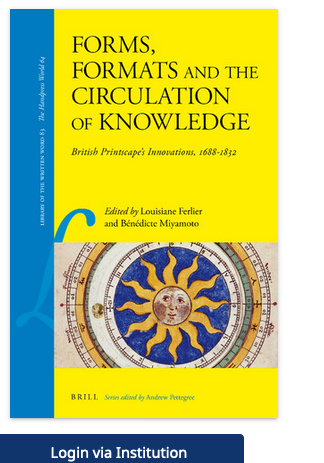C'est publié! Our aim in preparing *Forms and Formats and the Circulation of Knowledge* was to take the discussion of formats into the busy world of business transactions, copyrights, economic constraints, and the hustle and bustle of the #printshop (brill.com/view/title/579…)
https://twitter.com/Brill_History/status/1309885834385076224
Here is a look at the TOC - these contributors were a dream to work with: James Raven, Jeffrey Hopes, Rebecca Schoff Curtin, @ijalexander2002 , Yvonne Cornish, @katieparker18th, @cgspence, James P. Ascher, @Jacqui_R_Walsh, David Duff - and co-editor Louisiane Ferlier ! 



It opens with James Raven's meticulous survey of jobbing, which provided a regular income stream for printers hardly achievable with other forms of prints (blank forms, blank forms, everywhere!) 

Jeffrey Hopes establishes in Chapter 3, with publisher extraordinaire and format repackaging expert John Dunton, booksellers were a corporate group with both local and international reach to reckon with. Thus an increasing range of success and specialization in the #booktrade, 

Rebecca Curtin further shows that this authoritative po- sition was already recognized in the early modern period, as she explores in Chapter 4 the transactions between authors and publishers, since publishers’ leverage was reflected in ownership of the right to copy. 

In Chapter 5, Isabella Alexander proves transactions also animated the geographers' world. When maps were made and fought over in courts of law, it was their method of production and their final form which underpinned the legal arguments and the courts’ decisions. 

Yvonne Cornish in Chapter 6 with the Vauxhall Affray, shows that publishers moved very swiftly from one format to the other. They fuelled debates by seeking the production of more printed texts of all formats and genres – views, letters, and newspaper inserts. 

In the section [Per]forming Knowledge in Print, our contributors show the book has come to represent knowledge harnessed, and its neatly paragraphed printed text the ordering of ideas, when in fact...
...David Weinberger warns books reveal the “boundaries set by an economic system. To think that knowledge itself is shaped like books is to marvel that a rock fits so well in its hole in the ground.”
(A pic of our book display at the 2014 Oxford conf. starting point of this book)
(A pic of our book display at the 2014 Oxford conf. starting point of this book)

Sold in the retail shops of booksellers and printsellers as well as in specialty and instrument shops, maps and globes fell under the Engravers Act for litigation. @katieparker18th shows in Chapter 7 that this was because of their materiality and the engravers who made them. 

@cgspence in Chapter 8 shows that formats of accident news and catastrophy ballads anticipated the sensationalism of newspapers in their treatment of accidental deaths, influenced as they were by the Bills of Mortality format. 

James P. Ascher in Chapter 9 shows that compositors were responsible for shaping the physical page at the atomic level in meaningful ways. He draws our attention to #typography and the fact that we are limited today by the #digital tools we use to reconstruct historical type. 

In Chapter 10 @Jacqui_R_Walsh demonstrates that early modern and modern audiences were comfortable with the fluidity of paper structures and their shape-shifting. Their appreciation of metamorphic books shows that they collaborated to the books’ manifold meanings and formats. 

To conclude, small Formats relied on an ingenious inclusivity, an advertising device still being used a century later according to David Duff’s study of encyclopædia prospectuses and other ambitious publishing projects in Chapter 11 of this volume. 

Louisiane Ferlier and I's introduction on the Shape of Knowledge reconsiders the relationship between the materiality and authority of the book in the long eighteenth century. We hope to question any supposed monolithic model for the circulation of knowledge, then and today. 

This volume is dedicated to the memory of our teacher and mentor Robert Mankin (1952–2017) who shared his erudition on the circulation of ideas with such generosity. 

Louisiane Ferlier and I are so very grateful for the help and support of @royalsociety and @FolgerResearch @FolgerLibrary for their help with images
@threadreaderapp unroll
• • •
Missing some Tweet in this thread? You can try to
force a refresh








